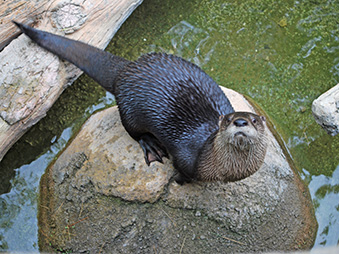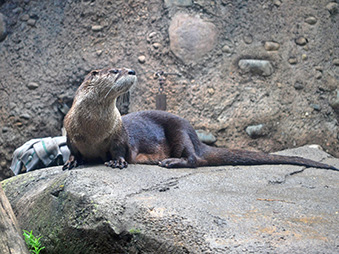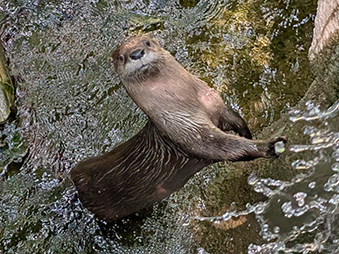Lontra canadensis | North American River otter
Name: Bootie and Evie (Female)



Meet Bootie and Evie
Energetic, agile, and endlessly entertaining—Bootie and Evie are our resident North American River Otters, and they always ready to make a splash! With their sleek bodies, waterproof fur, and curious nature, Bootie and Evie are fan favorites in the Train Whistle Café Plaza, located just across from our African Penguin habitat. Whether they are zooming through the water or sliding belly-first across their enclosure, you’ll quickly see why river otters are some of the most captivating animals in North America.
Life in the Water
North American river otters are semi-aquatic mammals, meaning they spend time both in and out of water—but they’re definitely built for the swim life:
- Webbed feet for powerful propulsion.
- A long, muscular tail that acts like a rudder.
- Dense, waterproof fur to keep their skin dry and insulated.
- Nostrils and ears that close when diving.
- Slightly nearsighted vision, perfect for seeing underwater.
- Sensitive whiskers (vibrissae) that help detect prey in dark or murky water.
Masters of Play and Survival
While Bootie and Evie might seem like they're just having fun, otters’ playful behavior—like sliding, tumbling, and mock fighting—builds critical skills for hunting, social bonding, and muscle coordination. Otters can:
- Swim up to 7 mph.
- Hold their breath for up to 4 minutes.
- Thrive in cold climates thanks to thick fur and fast metabolisms.
They're incredibly intelligent and curious, and like many mustelids (the weasel family), they never seem to sit still for long!
What’s on the Menu?
Otters are opportunistic carnivores, meaning they’ll eat whatever they can catch in their aquatic environment. In the wild, that includes:
- Fish
- Mollusks, like clams and snails
- Crustaceans, like crayfish and crabs
- Amphibians
- Reptiles
- Occasionally small birds and mammals
Bootie is a special case. She has special dietary needs, due to her sensitive stomach. This diet includes:
- Canned food
- Boneless tilapia, shrimp, and scallops
A Sign of a Healthy Ecosystem
River otters are considered an indicator species—which means their presence signals that the surrounding environment is clean and healthy. Because they rely on clean waterways to survive, polluted or degraded habitats quickly drive them away.
Unfortunately, river otters were once in serious decline across the U.S. due to pollution, habitat destruction, and unregulated trapping. But thanks to conservation efforts, cleaner waterways, and reintroduction programs, otters are rebounding in many areas and are now listed as Least Concern.
Still, habitat protection and pollution control remain critical for keeping wild otter populations stable.
Not only are North American river otters an indicator, but they are also a keystone species. A keystone species is an animal that many other plants and animals within their habitat rely on to keep the ecosystem balanced. They do this through population control of prey species. If prey species become too numerous, they can take over an ecosystem, causing overcrowding, resource depletion, and unchecked sickness.
Where Do They Live?
North American river otters are incredibly adaptable and can be found in both freshwater and coastal environments throughout:
- The United States (Alaska to Florida!)
- Most of Canada
- Rivers, lakes, marshes, streams, and even coastal shorelines
They’re most active at night and during dawn or dusk (that makes them nocturnal or crepuscular, depending on opportunity), and they’re usually seen alone or in small family groups.
Fact Sheet
Taxonomy
Genus: Lontra | Species: canadensis |
Kingdom: Animalia | Phylum: Chordata | Class: Mammalia | Order: Carnivora | Family: Mustelidae |
Favorite Enrichment Type
Duplo blocks, firehose toys/scratchers, scents, and puzzle feeders!
Life Span
- In the Wild: 8 to 13 years
- In Human Care: 20 to 25 years
Diet
- In the Wild: Fish, crayfish, amphibians, reptiles, and occasionally small birds and mammals.
- At the Zoo:
- Bootie has special dietary needs, due to her sensitive stomach. She is given canned food, boneless fish filets, scallops, and shelled shrimp.
- Evie eats a variety of fish including capelin, rainbow trout, salmon, herring, sardines, silversides, and lake smelt, as well as a ground carnivore diet.
Geographic Range
Alaska to Florida, and across most of Canada.
Habitat
River otters inhabit both freshwater and marine environments, including rivers, lakes, streams, marshes, and ponds.
Otterly Amazing Facts
- Part of the Mustelid family (relatives include weasels, ferrets, and badgers).
- Can hold their breath for up to 8 minutes.
- Use whiskers to hunt in murky water.
- Need clean water to keep their fur waterproof.
- Fur contains 600,000+ hairs per square inch.
- Once threatened—now making a comeback thanks to conservation!
Status: Least Concern
Conservation
Want to do your part? Recycle responsibly, avoid littering near waterways, reduce your consumption of single use plastic, conserve your water usage, and support wetland conservation efforts in your community!
North American river otters like Bootie and Evie remind us just how closely tied animal health is to environmental health. Their survival depends on clean water, balanced ecosystems, and respect for nature—things we can all help support.
How to Find Us
You can spot Bootie and Evie swimming and playing in their habitat near the Train Whistle Café Plaza, directly across from our African Penguin habitat. Whether they're diving, sliding, splashing, or snoozing—you’re in for a show!
